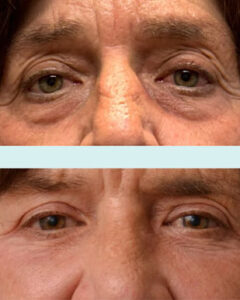 As we age, one of the most noticeable changes happens around the eyes. The lower eyelid and upper cheek area lose volume, the skin becomes thinner, and fat that once supported a smooth contour begins to shift. This combination leads to under-eye bags, hollowness, and the shadowed groove known as the tear trough.
As we age, one of the most noticeable changes happens around the eyes. The lower eyelid and upper cheek area lose volume, the skin becomes thinner, and fat that once supported a smooth contour begins to shift. This combination leads to under-eye bags, hollowness, and the shadowed groove known as the tear trough.
In this post, we’ll break down what causes these changes and discuss both surgical and nonsurgical options to restore a refreshed, youthful appearance.
What Happens as We Age
In youth, the upper cheek is full and smooth, supported by a layer of fat that cushions the underlying structures. Over time, this fat gradually dissolves, revealing the deeper anatomy beneath — including orbital fat, which surrounds and protects the eye itself.
Orbital fat is essential because it allows your eye to move comfortably within its socket. However, this fat is held in place by a thin membrane called the orbital septum, which can weaken with age or due to genetics. When that happens, the orbital fat begins to bulge forward, creating the appearance of under-eye bags.
At the same time, the loss of volume in the upper cheek exposes the bony rim beneath the eye — the tear trough — which forms a visible groove or hollow. This creates a three-part pattern that many patients notice:
- A bulge from the protruding orbital fat (under-eye bags)
- A valley or hollow from lost upper cheek volume (the tear trough)
- Another bulge lower down from the remaining cheek fat pad
This combination makes the eyes look tired or aged, even when you feel completely rested.
Surgical Correction: Restoring a Smooth, Natural Contour
For patients seeking long-term correction, a lower eyelid surgery (blepharoplasty) can address the underlying cause of the bags and hollowing.
During surgery, an incision is made discreetly inside the lower eyelid to access and remove the protruding orbital fat — eliminating the bulge. However, simply taking away fat can sometimes worsen the hollow appearance.
A youthful face is naturally full and rounded; removing too much volume can make the eyes appear older, not younger. To counter this, we often reposition or replace volume in the area to restore smoothness.
There are two main ways to do this:
- Fat Transposition – Moving the existing orbital fat downward to fill the tear trough area.
- Fat Grafting – Harvesting a small amount of fat (usually from the abdomen) and injecting it into the under-eye and upper cheek to replace lost volume.
Fat grafting is particularly effective because it replaces “like with like” — using your body’s own fat to restore what time has taken away. When the graft develops a healthy blood supply, it can provide a natural, long-lasting result, creating a smooth transition from the lower eyelid to the cheek.
Finally, the skin itself can be refined through laser resurfacing or a minor skin pinch to improve texture and tighten fine lines. These treatments target the surface layer while avoiding unnecessary disruption to deeper tissues, reducing the risk of complications.
Nonsurgical Alternatives: Fillers for Tear Trough Correction
For patients who aren’t ready for surgery, injectable fillers can provide a temporary improvement by filling in the tear trough hollow. This approach works by camouflaging the depression between the eyelid and the cheek, making the under-eye area appear smoother.
However, filler treatment has some limitations:
- It does not remove the bulging orbital fat — it only fills the hollow beneath it.
- Results are temporary, typically lasting 6–12 months.
- Fillers can sometimes cause issues if future surgery is planned, including scar tissue formation or lymphatic drainage problems.
- In patients with thin or fair skin, filler can occasionally create a bluish hue under the eye (known as the Tyndall effect).
Because of these considerations, fat grafting remains the preferred long-term approach for many patients — offering a natural texture, durable results, and fewer long-term complications.
Finding the Right Approach for You
Every patient’s anatomy and goals are unique. Some benefit from a conservative surgical approach with fat repositioning, while others achieve excellent results from comprehensive fat grafting or even non-surgical filler treatment.
During your consultation, your surgeon will evaluate your skin, fat distribution, and bone structure to create a personalized plan that restores smoothness and balance to the lower eyelid and cheek.
The goal is always the same — to achieve a refreshed, natural look that reflects how you feel on the inside.
